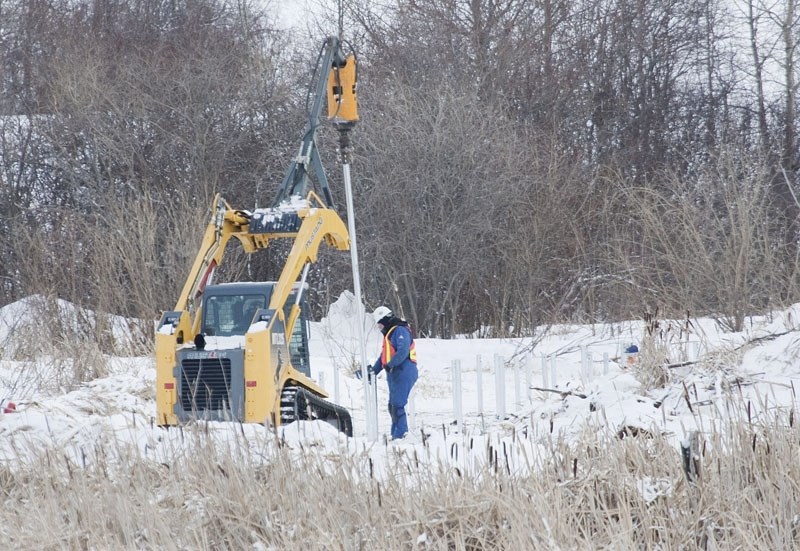Piles were spun and snow was flung this week as construction of a million-dollar boardwalk began in a wetland near Big Lake.
Crews began driving piles and laying planks in the wetland south of Riel Pond this week as work on the John E. Poole Interpretive Wetland got under way. The $1-million project, announced in 2009, is meant to give students an up-close look at wetlands and waterfowl.
Ducks Unlimited officials gave an update on the project Wednesday night during the Big Lake Environment Support Society’s annual general meeting at Sir George Simpson Junior High School.
Residents who wander by the site will see skid-steer vehicles, dirt and small galvanized-steel poles sticking out of the ground, according to Dale Soetaert, project manager for Ducks Unlimited.
The 400-plus-metre boardwalk will have many eco-friendly features, notes Jim Wohl, consultant on the project. The project’s 468 steel supports screw into the ground to avoid earth-shaking pile-driving, for example, and are chemically inert. “There are no treated poles or creosote or anything of that nature touching the water.”
The boardwalk itself is a wood composite made from recycled materials that does not leach, fade or splinter, he continues. PCL Construction workers are now pre-assembling the walkway at Hole’s Greenhouses & Gardens on Bellerose Drive, and may start laying sections of it this weekend.
Crews should be out of the marsh area before the birds return this spring, says Soetaert, with the path itself open to the public by this fall. “I’m targeting June 1 [for the boardwalk] if everything goes smoothly.”
This will be the group’s largest interpretive boardwalk in Alberta, Wohl says, and a major educational spot for nearby Lois Hole Centennial Provincial Park.
“This is a gorgeous little remnant of a beautiful wetland in a virtual urban ocean,” he says. “This one is going to be a real crown jewel.”
Call Soetaert at 780-930-1250 for any questions on the project.
Albertans could grow fruits and vegetables year-round using only the power of the sun, suggests a solar energy group.
Bill Swan of B.C.’s Groundswell Network Society will give a free talk Wednesday on how to build a solar-powered greenhouse. Swan and about 300 volunteers built such a building near a school in Invermere, B.C.
Swan says his group built the place out of concern for climate change and children’s health. “We have rising obesity rates,” he notes, and they’re due in part to poor food choices. This project aims to reconnect people with the source of their food to help them improve their diet.
The 3,000-sq.-ft. greenhouse uses solar electric panels and a geosolar system to generate its own heat and electricity, Swan says. “We are only relying on the sun to provide our heat.”
The geosolar system is pretty low-tech, Swan says. The summer sun heats the air in the greenhouse, which is sucked through underground pipes before it’s blown outside. Heat from the pipe leaches into the ground, where it stays for six months. “We’re basically storing summer sunshine.”
The greenhouse gets to a steamy 27 C in the afternoon even when it’s -3 C outside, Swan says. “We’re about to harvest our first spinach crop.” All the plants are grown, harvested, cooked and served by students from a local school, he adds.
This project should be of great interest to anyone interested in local food, says Rob Harlan, executive director of the Solar Energy Society of Alberta and organizer of the talk. “It’s been a wonderfully successful project.”
His group hopes to build a similar greenhouse in Alberta. Computer models suggest that such a greenhouse could operate year-round here with a minimal amount of outside energy.
The talk starts at 7 p.m. on Feb. 23 in the CN Theatre of Grant MacEwan University. Call Harlan at 780-439-5608 for details.




